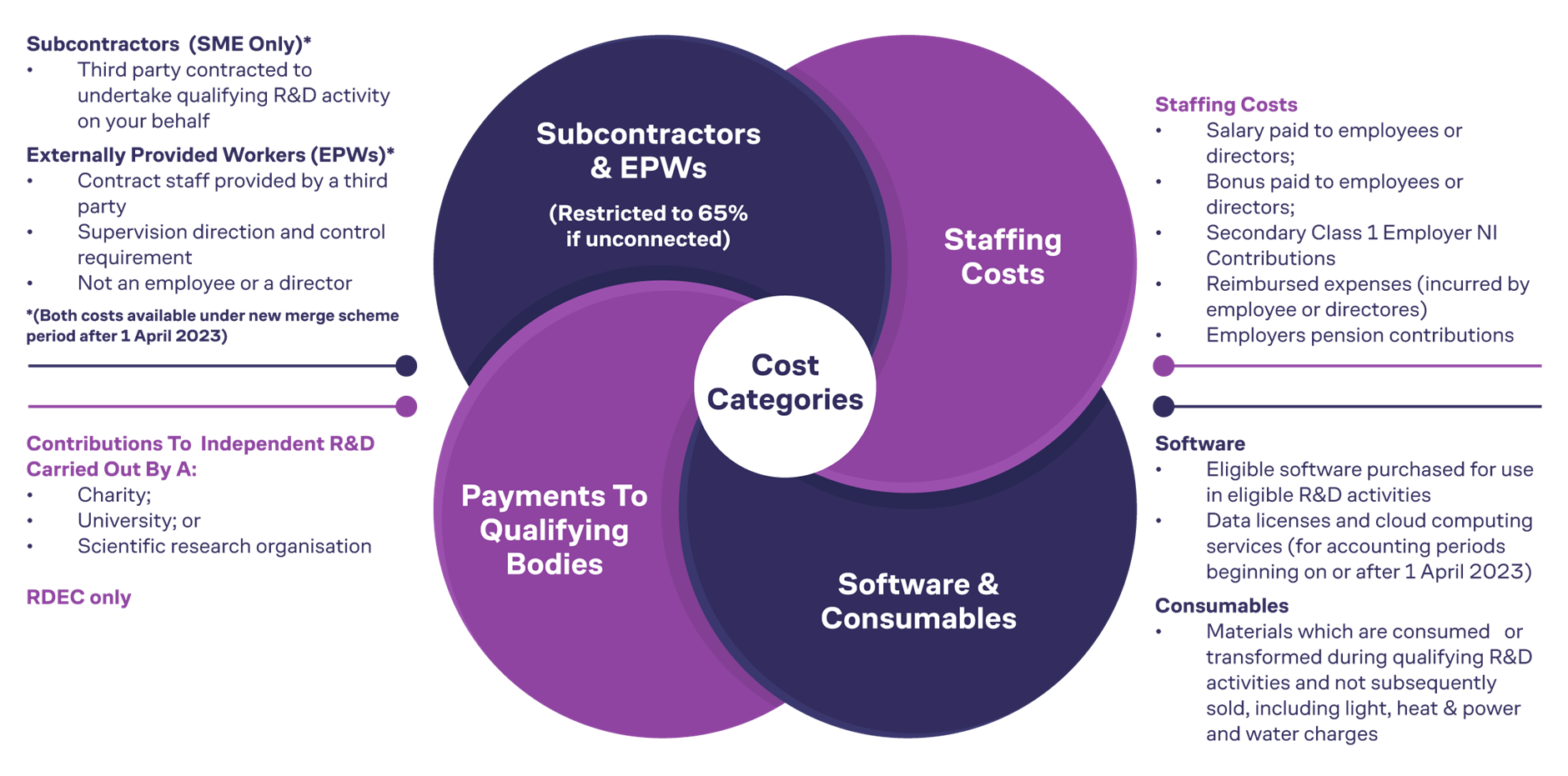R&D Tax 101
A comprehensive guide to R&D Tax relief
R&D tax incentives have seen substantial changes in recent years. While the new framework may seem more complex and risk-sensitive, it shouldn’t be a deterrent. With a reputable advisor expert guidance your business can still unlock valuable benefits—both for your organisation and the broader economy and society.
Here we explain what R&D tax credits are, the changes to the schemes, including the introduction of the merged and ERIS schemes and additional filing requirements.



Simba Mareverwa
Head of Compliance & Tax Disputes
- 20+ Years in Corporation Tax compliance, previously head of HMRC disputes at UK’s largest R&D Taxfirm
- Defended the most R&D Tax claims in enquiry by volume in the UK
- Principal in all client engagements and responsible for PCRT and ICAEW code of ethics compliance
What Are R&D Tax Credits?
Research and Development (R&D) tax credits are a UK government incentive aimed at encouraging innovation by rewarding companies that invest in advancing science and technology. These credits provide a valuable source of funding, enabling businesses to accelerate their R&D activities, expand their teams, and support long-term growth.
Why does the scheme exist?
First introduced in 2000 for small and medium-sized enterprises (SMEs) under Gordon Brown’s Labour government, the scheme aligned the UK with other countries already offering similar innovation-driven incentives. A separate scheme for large companies followed in 2002.
By stimulating investment in innovation, R&D tax credits play a key role in driving productivity and economic growth. They support the development of new technologies that not only contribute to commercial success but also generate broader social benefits.
Who is eligible?
R&D tax credits are designed to reward companies that are developing new products or processes or significantly improving existing ones. HMRC looks for advances in science and technology rather than advances in the arts or social sciences like economics. Whilst R&D can occur in every sector HMRC have outlined that R&D rarely occurs in sectors such as care homes, pubs and restaurants, hotels or professions like care or personal training and we would advise taking heavy precautions if you are contacted by companies to make a claim in this sector.
Is my business eligible for R&D Tax Credits?
-
 A UK incorporated company subject to corporation tax (but can be loss-making).
A UK incorporated company subject to corporation tax (but can be loss-making). -
 Be undertaking projects that aim to make an advance in science or technology.
Be undertaking projects that aim to make an advance in science or technology. -
 Face uncertainty in how to achieve that advance.
Face uncertainty in how to achieve that advance. -
 Use qualified R&D staff or contractors.
Use qualified R&D staff or contractors. -
 Have incurred relevant R&D costs (like salaries, software, consumables, subcontracted R&D).
Have incurred relevant R&D costs (like salaries, software, consumables, subcontracted R&D).
What Counts as R&D?
As part of your R&D Tax methodology, you will claim for the projects in which qualifying R&D occurred in the accounting periods in question.
You may have one or several R&D projects or an overarching commercial project that triggers the need for separate scientific or technological development as an R&D project.

Project
Project
Advance
Advance
Uncertainty
Uncertainty
Boundaries
Boundaries
How do R&D tax credits work?
Companies can claim 20% of their spend on R&D up to 27% of their R&D expenditure over the past two accounting periods as a reduction in their corporation tax bill or as a payable tax credit.
All claims made after the 8 th of August 2023 must include submission of an additional information form (AIF) prior to claiming.
Advanced Notification (AN) must be given within 6 months for accounting periods beginning on or after 1 April 2023, for example a company with an AP ending 31 st March 2024 must give notice by 30 th September 2024
You must submit a claim notification form if:
- You’re claiming for the first time
- Your previous claim was an amendment rather than as a first return in the claim notification window
- Your last claim was made more than 3 years before the last date of the claim notification period
What are my credits worth?
The new merged R&D expenditure credit scheme applies to accounting periods beginning on or after 1 April 2024. This brings both SMEs and large businesses under the same scheme and applies the same above-the-line credit rate of 20%.
Determining your company’s profitability, size, and the accounting period in which you wish to claim will determine the type and rate of relief you can receive, as illustrated in the table below.
Working examples under the merged scheme
A company spends £500,000 on qualifying R&D. If eligible under the 27% enhanced rate, it could receive £135,000 back as a tax credit or cash payment. If the company is not intensive it would receive £100,000 above the line which would be subjected to tax yielding a net benefit of £75,000 -£81,000.

The Enhanced Research and Innovation Support (ERIS) – an ‘intensive’ SME is defined as an SME whose total spend on R&D ≥30% total expenditure
What Costs Qualify for R&D Tax Credits?
Subtitle: Data and Cloud Computing Expenses
For accounting periods starting on or after 1 April 2023, businesses can now claim costs related to:
– Data licenses
– Cloud computing services, including data storage, hardware facilities, operating systems, and software platforms
Subsidised R&D Projects

What Costs Qualify for R&D Tax Credits?

Data and Cloud Computing Expenses
For accounting periods starting on or after 1 April 2023, businesses can now claim costs related to:
-
 Data licenses
Data licenses -
 Cloud computing services, including data storage, hardware facilities, operating systems, and software platforms
Cloud computing services, including data storage, hardware facilities, operating systems, and software platforms
Subsidised R&D Projects
Restricted or Removed Costs
For accounting periods beginning on or after 1 April 2024, costs associated with subcontracted R&D work and externally provided workers (EPWs) conducted outside the UK are generally no longer eligible. Exceptions apply only if:
- The necessary conditions for R&D are not present in the UK.
- Such conditions are present in the overseas location.
- It would be wholly unreasonable to replicate these conditions in the UK.
For example, R&D requiring active volcanoes would qualify under these exceptions.
Only the company that makes the decision to undertake R&D and bears the associated risk can claim relief. Subcontractors performing R&D on behalf of another company are not eligible to claim.
Now more than ever you need to review if you are still eligible to claim, our solution SecuRD® is uniquely positioned to help you time stamp decision making, safeguarding future R&D tax relief.
From 1 April 2024, payments made to third parties for independent R&D (not contracted or directed by the paying company) are no longer claimable.
Do you need assistance?
With increased HMRC scrutiny evaluating your company’s eligibility under the new rules or preparing the necessary documentations can feel overwhelming. At InnoFund we can deal with the complexities and ensure you are claiming with full HMRC compliance.
Sector Specialism
The merging of the R&D Tax scheme means new opportunities for large companies, with the introduction of the subcontracting cost category for Engineering and Construction companies, inclusion of data costs for PLCs with data migration projects and pure maths for the banking and insurance sectors.
-
Architecture
 Architecture
Architecture -
Construction
 Construction
Construction -
Software & IT development
 Software & IT development
Software & IT development -
Waste Management & Recycling
 Waste Management & Recycling
Waste Management & Recycling
-
Aquaculture & Fishing
 Aquaculture & Fishing
Aquaculture & Fishing -
Engineering
 Engineering
Engineering -
Agriculture
 Agriculture
Agriculture -
Food and Beverage
 Food and Beverage
Food and Beverage
Why are R&D tax incentives typically underclaimed?

Why does the scheme exist?
Who is eligible?
Eligibility Criteria:
To be eligible for R&D tax credits, your business must be:
- A UK incorporated company subject to corporation tax (but can be loss-making).
- Have carried out qualifying activities.
- Have spent money on qualifying R&D projects.
Sectors with qualifying R&D
Whilst R&D can occur in every sector HMRC have outlined that R&D rarely occurs in sectors such as care homes, pubs and restaurants, hotels or professions like care or personal training. We would advise taking heavy precautions if you are contacted by companies to make a claim in the above sectors.
-
Architecture
 Architecture
Architecture -
Construction
 Construction
Construction -
Software & IT development
 Software & IT development
Software & IT development -
Waste Management & Recycling
 Waste Management & Recycling
Waste Management & Recycling
-
Aquaculture & Fishing
 Aquaculture & Fishing
Aquaculture & Fishing -
Engineering
 Engineering
Engineering -
Agriculture
 Agriculture
Agriculture -
Food and Beverage
 Food and Beverage
Food and Beverage
What counts as R&D?
As part of your R&D Tax methodology, you will claim for the projects in which qualifying R&D occurred in the accounting periods in question. You may have one or several R&D projects or an overarching commercial project that triggers the need for separate scientific or technological development as an R&D project. To build a robust claim, you need to ensure that:
- The project is relevant to the company’s trading activities or industry.
- The focus of the project is to either create something new, improve existing solutions, or replicate something in a fundamentally different way.
- The advance must aim to move knowledge and capabilities beyond the existing baseline in science or technology.
- The work must involve scientific or technological uncertainty. It’s not enough to seek an advance; the work must go beyond the baseline knowledge and capabilities in the field.
- Given the constraints of your project and the information in the public domain, you must establish that the uncertainties would not be readily deducible or easy to solve by another competent professional in the field.
- The boundaries of the project relate to the uncertainties; once the technological/scientific uncertainty is resolved, so is the R&D project.
- Disqualify routine activities and only include activities and related costs up until the uncertainty is resolved.
Is my claim robust?
Our Head of Tax compliance Simba brings experience from having defended over 450 HMRC enquiries into R&D Tax (the most enquiries by volume in the UK) over the last 16+ years, he shares best practices in picking a provider and what makes for a robust claim in his article which you can read here.
Ensure your claim is SecuRD™
We built a product that we believe is the safest way to claim R&D Tax.
Find out how we are revolutionising R&D Tax claims
How do R&D tax credits work?
The new merged R&D expenditure credit scheme applies to accounting periods beginning on or after 1 April 2024. This brings both SMEs and large businesses under the same scheme and applies the same above-the-line credit rate of 20%.
Determining your company’s profitability, size and the accounting period in which you wish to claim will determine the type and rate of relief you can receive which is illustrated in the table below.

What costs qualify for R&D Tax Credits?

Which sectors have qualifying activities for R&D Tax?
Whilst R&D can occur in every sector, HMRC has outlined that R&D rarely occurs in sectors such as care homes, pubs and restaurants, hotels, or professions like care or personal training. We would advise taking heavy precautions if you are contacted by companies to make a claim in the above sectors.
What’s the Benefit?
Cash received from R&D can be reinvested into:
01
Further Development Projects
02
Hiring More Staff
03
Training
04
Capital Equipment
Complete R&D Solutions
Key Benefits
• Repeatable: Can be claimed for each accounting period if the qualifying criteria are
met.
• Boosts EBITDA: R&D Expenditure Credit Scheme (RDEC) boosts EBITDA by recognising the credit as additional income before tax relief.
• Increased company valuation – If related to a multiple of profitability or turnover.


